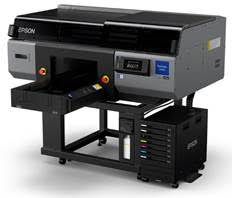The promotional textile printing family has a new member. In addition to sublimation and DTG (direct to garment), DTF (direct to film) has been added. Graphispag, as the international trade fair for the graphic arts and visual communication industry, reflects innovations in graphic processes and products as well as trends in the sector. One of the recent personalisation techniques is the DTF. We asked some experts on the subject about the advantages and the way ahead for this digital printing system.

Image courtesy of J. Pujol Maq. Conf SA
Also known by its acronym DTF, Direct to Film is a direct-to-film printing process to create a kind of digital transfer. Once printed, it can be applied to a wide variety of materials such as cotton and polyester.
There is a diversity of opinion among today’s printers on this technique. It is sometimes sold as a one-stop solution, but requires specific printers and consumables in terms of ink, pet film backing and powder adhesive. The main advantages include lower ink consumption and lower cost of printing equipment. It can also be used on most fabrics regardless of colour and has a high durability.
- Is DTF a winning textile printing technique?
Jordi Pujol, commercial director of J. Pujol Maq. Conf SA
It really is a good complement to DTG printing or traditional screen printing, but it is just that, a good complement. If we print an A4 size on a cotton T-shirt in DTG, it has a soft feel because the fibre of the garment is printed and it breathes. If the same print is made on DTF, it does not breathe and has a plasticky feel. In other words, the garment is not comfortable. On the other hand, DTF is a good solution for customising outdoor textiles such as backpacks, sweatshirts, trainers, bags, polyester, nylon…
Jesús Abad, commercial director of Distrigraf Digital S.L.
The DTF technique is undoubtedly a winning technique. It provides customers with the advantages of traditional screen printing with the benefits of digital printing. High quality results, strength and elasticity can be achieved with only a few units. Labour is reduced and production costs are more economical compared to the systems currently in use.
Pedro Martínez, manager of Hisarnox
It is a technique that is in great demand because it allows for tailor-made transfers that are valid for all types of fibres. Compared to other techniques, such as textile vinyl, it has a better feel and grips more fibres. Compared to screen printing, it is more convenient, quicker and cleaner to execute for short and medium runs. And it is profitable from the very first unit.
- Where is there room for improvement?
Jordi Pujol
As for the final result, the feel is undoubtedly the touch. DTF prints are very reminiscent of a vinyl finish, they have a plasticky feel to them. Another disadvantage is that they are not breathable. The process also needs to be improved, the current machines are too maintenance-intensive and the polyamide powders do not have OEKO TEX certificates.
Jesus Abad
We are in the early days of this system and the technique will surely mature, although the basics of how it works are already well established.
Pedro Martínez
It still has significant room for improvement. There are currently many variables that influence the process and work must be done to reduce the variability of each of the elements. The biggest complaint from users is that the equipment needs to be maintained on a daily basis. Printers would like it to be like eco-solvent presses in the sense that if you don’t do any maintenance for a while they are still ready as long as they are connected to their self-cleaners. In the case of the DTF, the sedimentation of the pigment in the white ink greatly conditions the maintenance to be carried out.
- Does the DTF popularise this type of printing by making it more affordable?
Jordi Pujol
No, the DTF provides a further solution to customisation. It is not more or less affordable than DTG or screen printing, it is just another solution, with its consumable costs (film, polyamide). It must also be taken into account that currently all small format or continuous roll DTF printers are subject to daily maintenance, head changes, print waste, etc… adding all this together makes them not so competitive. We are clearly committed to Epson’s DTG printing machines that allow DTF printing, i.e. with one machine they allow both DTG & DTF solutions without maintenance or printhead problems.
Jesus Abad
With this system our customers will be able to make a leap in quality and flexibility when offering this type of printing. They will also see their profit margins increase by reducing production time and material costs.
Pedro Martínez
The manufacture of transfers used to be carried out by highly specialised companies and the appearance of this technique has greatly opened up the market. On the other hand, with relatively low investments, short and medium runs can be produced at very competitive prices, which largely explains the boom in this technique. And in the case of people who work on similar products with textile vinyl, saving the peeling time is an advance that justifies the investment.
Cristina Benavides, Graphispag contributor




